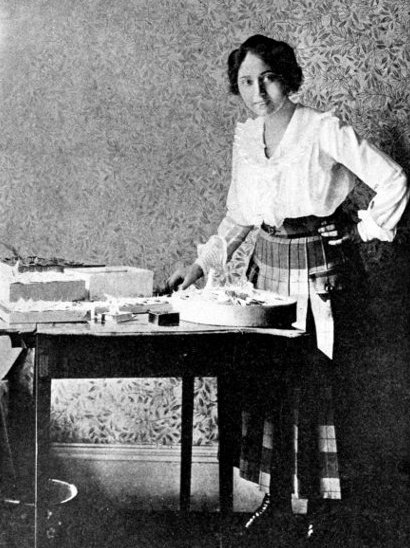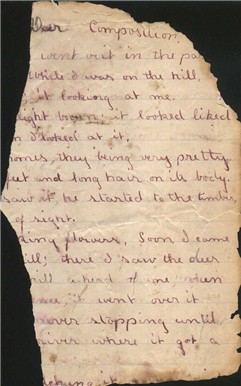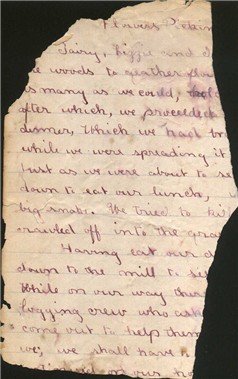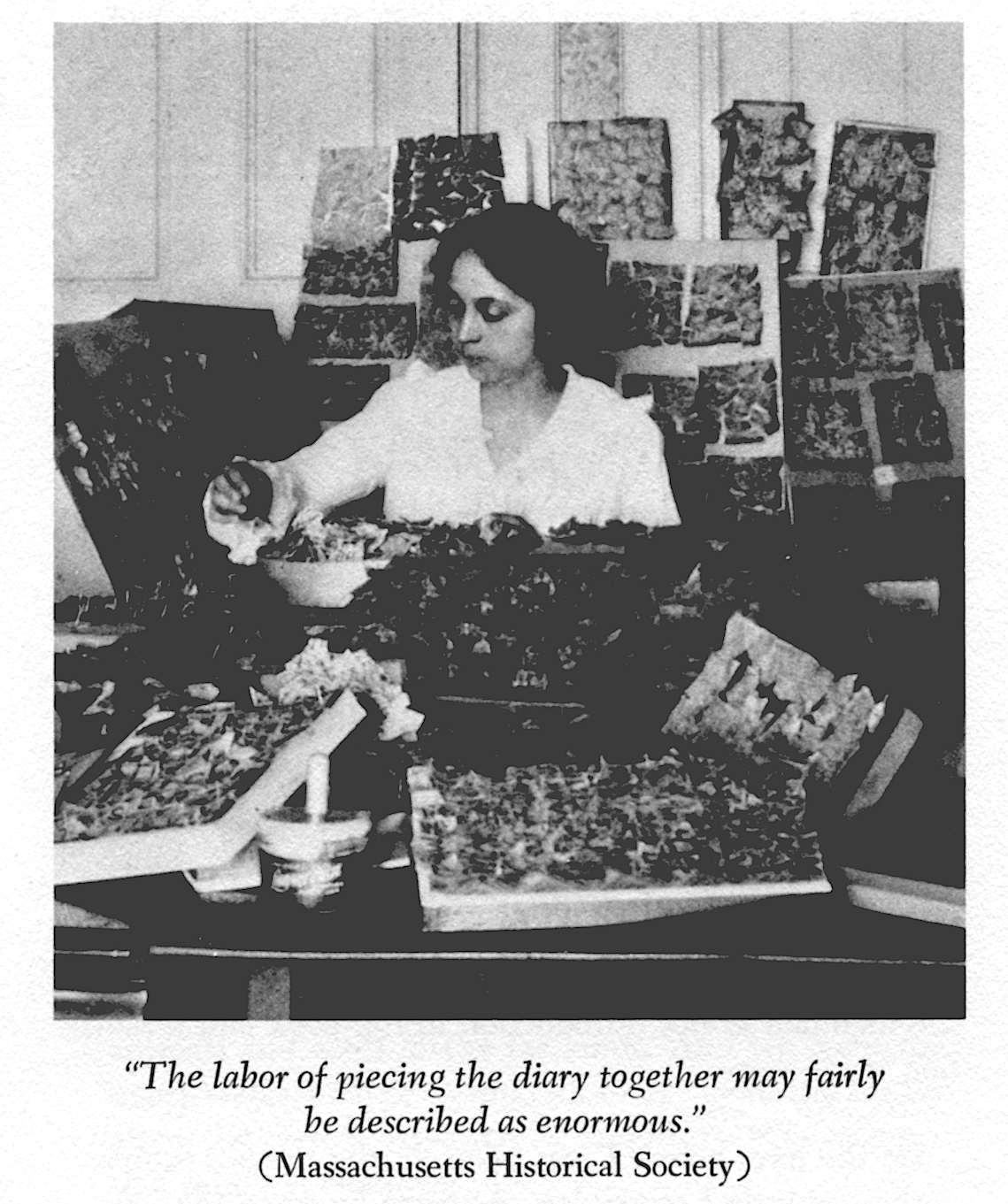Fragments from Opal Whiteley’s Lost Diary
Did She Keep a Diary When She was Young?
Was it Really Torn Up By Her Sisters?
By Stephen Williamson (c) 2001

How this Diary Fragment was Found
On July 20, 1999, the Dorena Oregon post office held a 100th birthday party. Postmasters Katie Vaughn and Rosemary Bird organized it. Community groups put up tables with information about local history and many people brought their own family photos albums. On behalf of the University of Oregon’s Center for Electronic Studying Curtis Irish, Patrick Whitmer and I went to the event looking for historic photographs.
We set up a table of Opal Whiteley information. Many residents brought old photographs and books to share. We would not have been there had it not been for the help of Dr. Lynne Anderson-Inman and Dr. Mark Horney who wanted to gather as many period photographs as possible for Project INTERSECT’s online edition of Opal’s diary.
A woman named Diane Slater approached me with an old book. II was a large, ornate book titled “An Illustrated History of Central Oregon”, and published in 1905. She said that her late husband, John Pitcher, owned it. Diane Slater asked me what group might be interested in it. I thumbed through the book and recommended that she donate it to the Cottage Grove Genealogical Society because of the many names of places and families in it. Mrs. Elaine Munroe agreed to take it to their library where it could be seem by people researching their families.
The old book had a few items that had been put in to preserve them. There were a couple of dried trillium flowers and a few personal notes. Clearly, someone used this old book to keep things that were sentimental to them.
In the middle of the book, I found an old folded piece of notebook paper. Inside the folded paper was another smaller piece of paper. It was this torn fragment from someone’s diary. At the time I did not know it could be was Opal’s. I told myself that the odds were a thousand to one against it, but I still got a chill up my spine each time I looked at it. A few months with more research and the odds began to look much more like it was Opal’s. Now, two years later, I am convinced it is from her diary.
The diary of Opal Whiteley is the last literary mystery of the 20th century. If this fragment is from Opal’s diary, it is a very valuable piece of history. It may not have great monetary value, but its importance to the story of Opal Whiteley cannot be overestimated. This fragment is now in the University of Oregon Library’s Opal Whiteley Collection.
Why this Fragment is Likely to be Opal Whiteley’s
1) The handwriting appears to be very similar to Opal’s.
Opal was right-handed, but often wrote with a unique left-handed slant. This fragment has that unique handwriting element. Because of the two other girl’s names and their activity of picking flowers, it is most likely a girl or young woman writing in her journal.
This rare piece is not from the early childhood diary (age 6 & 7) that was published. I believe it to have been written when she was about eleven or twelve. There are a few entries of her later diary from ages nine and ten. The book she wrote at age nineteen, “The Fairyland Around Us,” is filled with direct quotations from the diaries she wrote as a youth. Each of Opal’s books contains entries from the diaries she kept.
Several major experts on Opal Whiteley believe this fragment is Opal’s. This includes Benjamin Hoff, Rob Naslin, her childhood friend, Ida Schurtz [1] and me. Each of these people has seen Opal’s handwriting over the years. Everyone familiar with Opal’s writing believes it is hers. Here is a copy of her six-year-old writing and a copy of her signature in Hoff’s book (age 20) plus, a letter Opal wrote at about age 65 [2]. Each shows letters slanting to the left. All four examples of Opal’s handwriting have this left slant.
2) This fragment was deliberately torn up, the way Opal says her diary was.
The fragment is one quarter of an 8/11 page. We have the top left and the top right parts of the page. It probably came from an old fashioned school composition notebook with a glue binding. There are parts of two paragraphs on each page.
The fragment was ripped out of the book, as evidenced by the ragged left-hand margin. It was in the composition notebook when it was torn out [3]. This is what Opal said happened to her diary when a younger sister tore it up.
After tearing this page out of its notebook, someone tore it twice again, both vertically and horizontally for a total of three separate motions. Judging by the way this paper was torn, the person was probably angry. The left margin shows it was literally ripped from the notebook. It did not break into fragments because of age[4].
3) This paper was found in a book originally belonging to the Pitcher family.
This small piece of paper was important to someone. Important enough to be preserved for over 90 years between the pages of a large book called “An Illustrated History of Central Oregon”, 1905) [5]. The Pitcher family traded supplies from Eastern Oregon. There were several families of Pitchers, all related. They lived in the same areas as Opal’s family – Star, Wildwood and Dorena. There is also a “Pitcher Creek” at Star [6].
The Pitcher families lived along Row River in several places where the family of Opal lived. One of the original settlers named Miles Pitcher was a postmaster at Star Oregon before Opal’s mother worked there [7]. It was hard to grow up in the Row River Valley and not know the Pitchers. Opal stated that her diary was torn up when she was about twelve years old in Star. This would have been between 1908 and 1910. One branch of the Pitcher family lived in Star at the time Opal says her diary was torn up [8].
Opal’s critics have speculated that she wrote (and tore up) her own diary. They believe this could have happened when she was in Los Angeles in 1919 – or even as early as Star. However, this fragment refutes that idea. This piece of Opal’s diary has never been out of Oregon. The book it was in has never been out of the Row River Valley [9].
Opal is said to have given a piece of the diary she loved to someone she cared about. There are several stories of Opal giving pages of her diary to people. In Elbert Bede’s 1920 notes there is a mention that in 1911 (two years after she said her diary was torn up) Opal left a “piece of copy for diary in book” with Mrs. Thompson [10].
4) The writer beings her diary entry as “Dear Composition”, not “Dear Diary”.
Opal was known to use this salutation. Elbert Bede’s 1920 notes read “Sentinel, May 15, 1915 – after tenth birthday attending Star school: “in an old composition book I have written many interesting things of my school days there” [11].
Bede wonders “why in old composition book and not in diary?” He did not realize that by age ten, Opal was writing her diary in common school notebooks. These were called “Composition Books” and had mottled red cardboard covers. There is a piece in the 1920 Atlantic Monthly that quotes Opal writing in an “old composition book”. Rob Naslin, whose family knew Opal for many years, also confirms this. Opal told him that she wrote in school composition notebooks[12].
5) The writer is interested and keenly observant of nature using rich details.
In the four partial paragraphs, that we have the writer mentions many things in the environment. The writer describes three girls picking flowers in the woods and pasture near a logging camp that is by a river. They see a deer, a snake and at least one other forest animal. This could easily describe Star, Oregon which was next to the Row River with a lumber mill. It is probably springtime or early summer. While the girls are eating their lunch a logging crew comes by and jokingly asks if they are going to help them.
The fragment also has the high degree of detail that Opal used when writing. For example, she often described looking at an animal and the animal looking back at her. She does not just say that she “saw” an animal – but that the animal saw her too. Opal’s published diary and her Fairyland book have many such interactions.
In the first paragraph of the fragment the author describes looking a deer looking at her and she looking back at it. The partial paragraph reads ” …it looking at me,…light brown; it looked liked….I looked at it.” The deer is light brown colored and after looking at her runs away towards the timber and the river. Opal’s style is descriptive.
This writer also uses the word “home” where other writers might use more animal terms such a den, lair or nest. From my own study of her writings Opal more often used the word “home” to describe where an animal lives.
The fragment also describes the girls seeing a “big snake” and trying to kill it. One reviewer of the fragment believed that Opal would not have done this. At the time rattlesnakes were major problems in the Row River Valley. The local hill named Cerro Gordo was also called “Rattlesnake Hill”. Hunters often had Saturday rattlesnake hunts [13] .
In the University of Oregon archives is a photograph of a teenaged Opal shooting a rifle near a pond. Another UofO paper written by Opal is a defense of selective logging (not clear cutting) [14]. Readers 100 years later may forget that Opal grew up in a rural environment where hunting, fishing and logging were normal parts of everyday life.
6) The writer uses a semi formal, almost stilted style of writing.
For example, she uses archaic phrases such as “we shall have to” and “they being very pretty”. Elbert Bede and Benjamin Hoff have written about this characteristic of Opal’s speech and writing. This is also seen in a part of her diary written at age ten, and typed in 1920 and in her published childhood diary[15].
7) The writer uses the names of two local girls, “Fairy and Lizzie”.
This is some of the strongest internal evidence in favor of this fragment being written by Opal in about 1909 when she was eleven or twelve years old. Opal had wanted to write an article called “School Days at Star” and another called “On The Hill, at Star” [16] .
According to Ida Wicks Schurtz, these are probably the names of her cousin, Lizzie Wicks and Fairy Allen [17]. A major piece of evidence for Opal’s authorship of this fragment is the 1909 class record for the Star School that she attended.
The 1909 list of students at the Star School lists Opal (age 12), Pearl (age 11) and Fay Whiteley (age 6). Also, there are two students whose names appear in this fragment, Fairy Allen (age 19) and Lizzie Wicks (age 16) [18] .
While “Lizzie” is a common enough name, the name of “Fairy” is much less common. Each of the girls was in the Junior Christian Endeavor. Ida Wicks Schurtz knew Opal when she lived at Star when her diary was torn up. Mrs. Schurtz remembered that “Opal was about 12 and I was around six or seven. It was pure joy to be with Opal. I have never forgotten my summers with her. To her I owe my love of nature. Through her I learned to see beauty in everything [19].”
It is also possible that the Fairy and Lizzie referred to are actually Opal’s own mother, Lizzie Whiteley and her youngest sister, Fay (whose name means Fairy in Latin). However, I have not seen that Opal ever used the name “Lizzie” when writing about her mother in her diary. Opal calls her either “Mother” or “the mamma” in her diaries.
Did Opal Whiteley really keep a diary as a young child and was it torn up?
Elbert Bede answered the question of whether or not Opal kept a diary before age 14 in 1933. Bede was perhaps her most persistent critic. Below are quotations from a newspaper article he wrote for the Portland Oregonian in 1933. The article was also reprinted in the Cottage Grove Sentinel. This article contains new insights into Opal’s diary.
In his article Bede tells of new evidence that he had just obtained that he could not get when he was writing his articles in 1920. Bede does not mention this in his 1954 book “Fabulous Opal Whiteley”. So far as I know, these words have not been quoted since 1933 yet they answer one of his own questions in the mystery of Opal’s diary. These unequivocal words by Bede are not repeated in his book twenty years later.
‘Since I wrote a decade ago… a source of information then closed to me has been unexpectedly opened. As a result I have at last reached a person who actually saw Opal’s child diary, for the first time definitely establishing the fact that Opal had one that was produced at the time in her life that she claimed was written, the one she presented to the Atlantic Monthly…”
Heretofore every lead had resulted in the information that Opal had spoken of such a diary, or that she had read to someone out of what she said was her diary. Every lead was to a diary written, not printed. Also, these portions of the diary were in composition books or in tablets supplied by the father.”
“But now I have found one who saw a portion of a printed diary. Also, it was on pieces of wrapping paper and other scraps. Also, it had been torn into bits and kept in a cardboard box… Tears came to the eyes of the wounded creature as she bared the shredded, mutilated record of her early life.”
“Except that I have it from one in whom I have the most implicit confidence testimony that she saw the tattered remains of a child diary, I should doubt whether any portion of it was ever written as a child” [20]. Elbert Bede, 1933
There has been too much controversy over whether Opal’s diary was torn up by her sisters
Younger sisters of Opal’s always denied ever destroying her diary. However, it is important to remember that the girls were 12, 11 and 6 years old – just children. Siblings often destroy each other’s things – and tear up diaries. Every woman knows someone whose diary was torn up when she was young. This is normal for children of 12, 11 and six. The kids could not have known they were destroying a future best seller!

DIARY FRAGMENT PART 1
Top Left Quarter of 8/11 Page
“Dear Composition,
“… we went out in the pasture…
… while I was on the hill,…
…it looking at me,…
…light brown; it looked liked…
…I looked at it.
…homes, they being very pretty
…feet and long hair on it’s body…
…saw it, he started to the timber,…
…of sight.
NEW PARAGRAPH
…bring flowers. Soon I came…
…hill; there I saw the deer…
…hill ahead of me; when…
…saw me, it went over it…
…never stopping until…
…river where it got a…
(unreadable)

DIARY FRAGMENT # 2
Top Right Quarter of Page 2
This would be the top right of the other side of the page. This entry may also be from a different day.
” Flowers Picking”
…Fairy, Lizzie and I…
…the woods to gather flowers…
…as many as we could; ???…
…after which we had to bring…
…while we were spreading it…
…just as we were about to sit…
…down to eat our lunch,…
…big snake. We tried to kill it…
…crawled off into the grass.
NEW PARAGRAPH
…Having ate our dinner…
…down to the mill to see…
…while on our way there…
…a logging crew who asked…
…come out to help them…
…we shall have to…
(unreadable)

Footnotes for the Diary Fragment Report
[1] Personal communications from Hoff, Naslin and Schurtz, August 1999
[2] Sample of Opal’s signature at age 22. Benjamin Hoff, The Singing Creek where the Willows Grow 1986 title page. Also copy of letter written at age 70 – writings slant left.
[3] Elbert Bede book, Fabulous Opal Whiteley, 1954 pages 32 & 33
[4] Personal communication with handwriting expert Marie Otten, September 1999
[5] Personal communication with Diane Slater, widow of John Pitcher, July 1999
[6] Metsker’s Map of Lane County, 1995 and 1900 Railroad map both show Star & Pitcher
[7] Both Pitchers and Whiteleys at Star Post office: Cottage Grove, Golden was the Past, 1850-1970 page 211 and a “Record of Opal Whitely”. 1920 research manuscript of unknown origin in the Mass. Historical Society, pages 6 and 7.
[8] Lane County Historian, Summer 1980 – Lane County Historical Society
[9] Sample of Opal’s signature at age 22. Benjamin Hoff, The Singing Creek where the Willows Grow 1986 title page. Also copy of letter written at age 60 – writings slant left.
[10] Elbert Bede Notes, 1920 – Mass. Historical Society, Boston “Corroborative”
[11] Elbert Bede Notes, 1920 – Mass. Historical Society, Boston “Inconsistencies”
[12] Personal communications, Robert Naslin, Sept 1999, author and longtime friend
[13] Stephen Williamson article, How Cerro Gordo Mountain Got It’s Name, 1995,
Cottage Grove Historical Society archives
[14] University of Oregon, Opal Whiteley photograph collection, Opal with rifle near pond
[15] Personal communication with Diane Slater, widow of John Pitcher, July 1999
[16] Elbert Bede book ,Fabulous Opal Whiteley, 1954 pages 163 & 164
[17] Ida Wicks Schurtz, Personal communication, September 1999
[18] 1909 school records of students attending the Star School, (Lane ESD)
[19] Ida Wicks Schurtz quoted in Opal Whiteley, the Continuing Mystery”, 2001 page 104
[20] Elbert Bede article in the Oregonian, September 28, 1933, reprinted in Cottage Grove